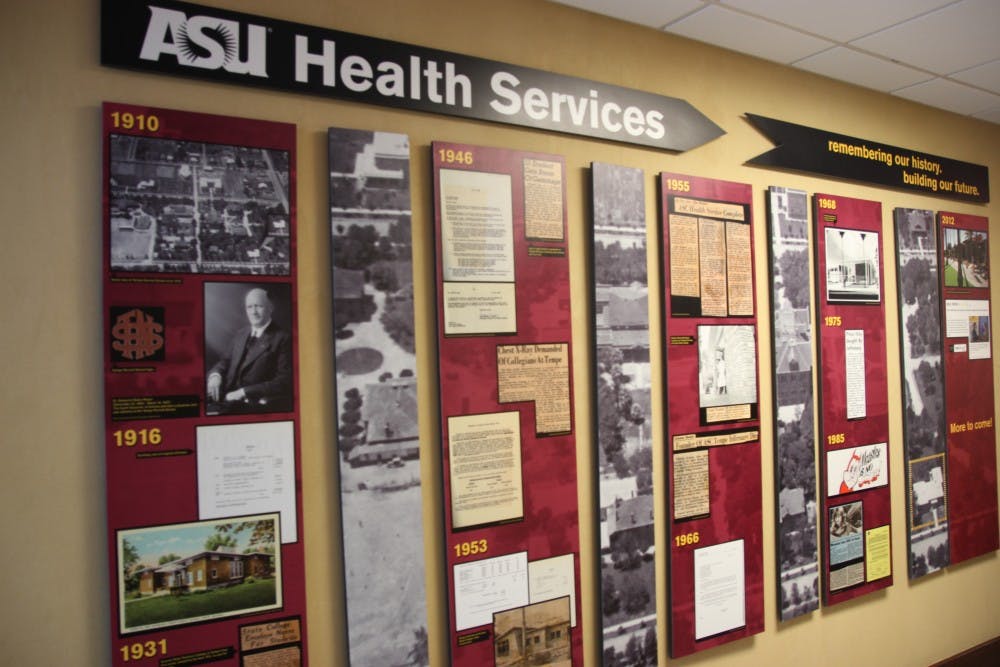In the span of almost six years, I have been to ASU Health Services only four times. Three times were for a doctor’s note (I was sick and I needed a proper form of an excuse last minute), the other was for a routine Pap smear and sexual health exam.
These four visits were all during my junior year. I haven’t been back since.
But I have since learned there’s much more to the ASU Health Services than you’d think. For someone who’s only been to one part of the center, I was surprised to see how much ASU Health Services had to offer.
Timeline
1946: Elaine McFarland was a nurse who lived on campus and established a health service center for ASU.
1953: ASU provides a building. It was structured like an infirmary, complete with 26 beds, one physician, a laboratory and an X-ray machine.
1953-1968: A gynecologist and a psychiatrist were included in the health services. At the time, the Arizona Board of Regents did not want to believe that mental illnesses existed, so they hired a psychiatrist in order to prevent mental illnesses.
1969: ASU Health Services hires their first physician director, Richard Jones.
1978: ASU Health Services becomes the first college health service to be accredited by the Accreditation Association for Ambulatory Health Care.
1980: ASU Health Services closes the infirmary and becomes ambulatory care.
1993: ASU Health Services utilizes a fully integrated computer billing system.
1999: ASU West opens its own health service center under ASU Tempe campus supervision.
2004: Mary Romea, working with Stefanie Schroeder opens psychology programs complete with interns and offers psychological consultation. ASU Health Services creates a Pandemic Executive Committee. During this time, there were concerns in regards to H1N1 virus.
2005: ASU Health Services fully utilizes electronic health records.
2008: ASU Health Services creates a "Wellness Department," offering services of acupuncture, chiropractic and massages.
2011: ASU is the first college center to become part of Mayo Clinic Care, allowing for more research opportunities in a clinical setting. The idea behind the collaboration was to help ASU students seamlessly transition into health care services provided by Mayo Clinic after graduation.
2015: ASU Health Services undergoes renovations.
So, what’s the big deal?
With recent headlines of branding the title of “most interdisciplinary school,” ASU has much to be proud of and ASU Health Services is a surprising part of it.
“Students have a lot of input on how we do business," says Schroeder, the Medical Director and Chief of Clinical Staff at ASU Health Services. "Aaron Krasner, PhD, the Assistant Vice President of ASU Health Services, meets with students periodically and we take all comments [and feedback] seriously."
An example of this is with the recent renovations of the clinic. Student input was highly valued, and it was the students who picked out the details, like the design, colors, and carpet, on how to build the new center.
In the past Health Services along with other student groups have lobbied for initiatives such as ASU's tobacco-free campus initiative.
ASU Health Services Goals
Maybe I took Health Services for granted; someplace I could go to when I needed a doctor’s note for a cold or for a last-minute appointment. But it’s so much more than that.
The clinic is currently working on future goals to deliver health services more efficiently without depersonalizing it and making health care accessible anywhere for students.
“When you feel stressed, wherever you go, we’ll get you to the right place. It’s not us versus them, we want all of us together, “ Schroeder says.
Health Services is working on telemedicine, allowing students in the residence halls connect with physicians using technology, bringing together all the health services, such as counseling and finding other ways to reduce stress to expand the program.
Secret Gems
Many students aren't aware of the Wellness Center, which offers acupuncture, chiropractic care and massages.
“It’s preventative,” Schroeder says. “You don’t [necessarily] need it to take care of yourself.”
But who could ever decline a massage and say that it’s not important for your health?
There’s also a pharmacy ATM inside the Health Services center, providing students with certain over-the-counter medicine and prescription drugs.
Due to the Affordable Care Act, ASU Health Services Pharmacy closed, and as an alternative, they implemented a machine to help make medicine more accessible. The machine provides ibuprofen, antibiotics for strep, Plan-B pill, and other pharmaceutical drugs.
Punch in your pill, submit payment and you have something to take care of your health. If you have questions, there’s a phone that can put you in touch with a pharmacist as well.
“We take a bit more time [than other healthcare services] and it’s important in this age range to connect," Schroeder says. "There should not be a stigma. All are part of health."




